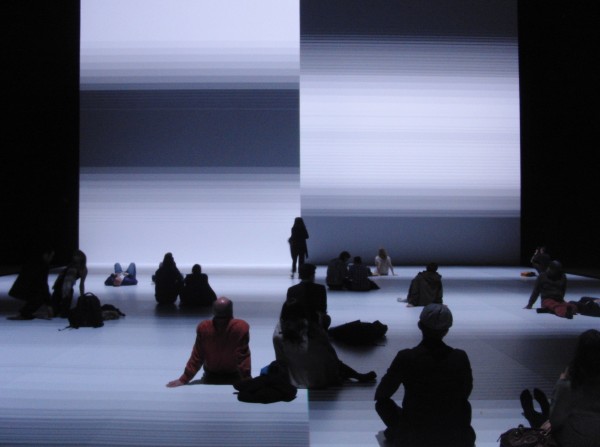
Ryoji Ikeda’s “test pattern (enhanced version)” invites viewers into a dazzling display of light and sound (photo by twi-ny/mdr)
Park Ave. Armory
643 Park Ave. between 66th & 67th Sts.
Through June 11, $12 (children ten and under free)
212-933-5812
www.armoryonpark.org
twi-ny slideshow
Japanese multimedia artist Ryoji Ikeda has created quite an audiovisual rave at the Park Ave. Armory, and no E is necessary to feel it pulsate through your mind and body. Ikeda’s three-part installation, “the transfinite,” combines the beautiful with the sublime, filling the fifty-five-thousand-square-foot Wade Thompson Drill Hall with a dazzling sound and light display built around experimental digital music and mathematically based projections. “For this project, the invisible multi-substance of data is the subject of my compositions,” he explains in his artist statement. “Ikeda is drawn to that which is at the edge of comprehensibility and human perception, and he distills it into an experience we can viscerally and physically connect to,” adds artistic director Kristy Edmunds. The first section of “the transfinite” is “test pattern [enhanced version]” (2011), a fifty-four-foot-high wall and fifty-four-foot-long floor on which computer graphics are projected, a thirty-minute series of black, white, and gray lines, boxes, and blips, synchronized to a digital score and stroboscopic effects. You can sit or stand on the floor (shoes off) as the lights are projected onto you as well, immersing everyone in the dizzying, hypnotic surroundings. The closer you get to the screen — we recommend getting right up against it both forward and backward, staring straight up — the more physical it all feels, and snippets of color, especially down the dividing line between the two sides of the projection, become visible. Sit back down and close your eyes for yet another type of thrilling experience, as shadows flit across your brain. On the other side of the screen, “data.tron” (2007-11) consists of mathematical equations, Matrix-like progressions, datatronics, and other digital imagery synched to the same musical composition in a fabulous fury of technological wizardry. Stand in front of it and the numbers are projected onto your body, fusing human and computer. The third part of the installation, “data.scan [1×9 linear version]” (2009-11), features nine monitor boxes, arranged in a vertical line, that depict various digital patterns, some that match up with “data.tron” and others that resemble 1980s video games and Terminator-like visuals. An engaging, involving symphony of sound and vision, “the transfinite” is best seen if you give yourself over to it, allowing it to merge with your soul.